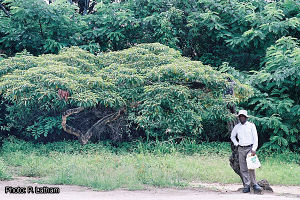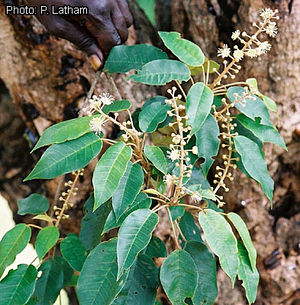Croton mubango (PROTA)
Introduction |
| General importance | |
| Geographic coverage Africa | |
| Geographic coverage World | |
| Spice / condiment | |
| Carbohydrate / starch | |
| Essential oil / exudate | |
| Medicinal | |
| Ornamental | |
| Forage / feed | |
Croton mubango Müll.Arg.
- Protologue: Journ. Bot. 2: 338 (1864).
- Family: Euphorbiaceae
Vernacular names
- Mubango (Po).
Origin and geographic distribution
Croton mubango is known from the Central African Republic, Gabon, DR Congo and Angola.
Uses
In DR Congo the bark pulp is rubbed onto the gums and teeth to treat toothache, and is also applied to haemorrhoids, hernia, skin eruptions and pain in the joints. The body is rubbed with a bark maceration as a tonic. A bark decoction is taken to treat gastritis and painful periods. The bark, together with the seeds of Monodora myristica (Gaertn.) Dunal, is eaten to treat abdominal pain and expel intestinal worms. Powdered root or a root maceration is taken to treat diarrhoea and dysentery. The leaves are eaten to ease pain, and a leaf infusion is used as a body wash to treat fever. A stem bark decoction is also taken to treat abdominal pain and fever. In the Equator province of DR Congo a decoction of crushed stem bark is taken to treat an enlarged spleen and tuberculosis. Powdered bark in palm wine is taken to treat oedema. Young fruits soaked in palm wine are taken as a laxative.
The bark of young twigs is used as a condiment. In DR Congo Croton mubango is planted as a shade tree in villages. The scented flowers are very attractive to bees. Edible caterpillars (Lobobunaea phaedusa) feed on the leaves. The resin from the trunk is used to trap birds.
Properties
Preliminary screening showed the presence of flavonoids, sterols, triterpenes, saponins and reducing sugars. Stem bark extracts showed weak antibacterial and anti-amoebic activities in vitro.
Methanolic, dichloromethane and aqueous stem bark extracts showed antiplasmodial activity against Plasmodium falciparum in vitro. At a daily oral dose of 200 mg/kg, the dichloromethane extract, the petroleum-ether, chloroform, ethyl-acetate and residual water-soluble fractions showed antiplasmodial activity against Plasmodium berghei in mice. The aqueous extract of the stem bark showed relatively low toxicity in mice. It significantly increased the serum concentrations of glutamate-oxaloacetate transaminase and glutamate-pyruvate transaminase in mice. In-vitro antibacterial screening of the stem bark extract showed no activity against enteropathogens.
The wood is hard and white.
Description
- Monoecious shrub to medium-sized tree up to 17 m tall; bole up to 30 cm in diameter; branches spreading, twigs drooping, densely covered with scaly and stellate hairs.
- Leaves alternate, simple and entire; stipules 4–5-partite, segments linear, 4–12 mm long, persistent; petiole 2–10 cm long; blade elliptical to ovate, 4–16.5 cm × 2–9 cm, base cordate to rounded, with 2 large basal glands, apex acuminate, thinly stellate hairy above, scaly and grey below.
- Inflorescence a slender, terminal raceme 7.5–20 cm long, covered with scales, mostly with male flowers in upper part and 1–4 female flowers at base.
- Flowers unisexual, 5-merous, regular, white; pedicel (2–)5–12 mm long; sepals triangular, 4–5 mm long; petals ovate-elliptical, 3.5–5 mm long, hairy on both sides; male flowers with 22–37 stamens, free; female flowers with superior, depressed-globose ovary, densely scaly hairy, 3-celled, styles 3, 3–4 times 2-fid, spreading.
- Fruit a rounded capsule 18–23 mm in diameter, covered with scales, 3-seeded.
- Seeds ellipsoid, 13–15 mm × 9–12 mm, brownish.
- Seedling with epigeal germination.
Croton mubango flowers from July to September.
Other botanical information
Croton comprises about 1200 species and occurs throughout the warmer regions of the world. It is best represented in the Americas; about 65 species occur in continental Africa and about 125 in Madagascar.
Ecology
Croton mubango occurs in margins of dense forest, secondary forest and tree savanna.
Genetic resources
Croton mubango occurs in disturbed forest and savanna and is probably not uncommon. Currently it is not threatened by genetic erosion.
Prospects
Croton mubango is used to treat a wide variety of diseases, especially in DR Congo. Although the antiplasmodial activities of the stem bark are promising, not much is known about the compounds responsible for this action. Additional research is warranted.
Major references
- Latham, P., 2005. Some honeybee plants of Bas-Congo Province, Democratic Republic of Congo. DFID, United Kingdom. 167 pp.
- Léonard, J., 1962. Euphorbiaceae. In: Robyns, W., Staner, P., Demaret, F., Germain, R., Gilbert, G., Hauman, L., Homès, M., Jurion, F., Lebrun, J., Vanden Abeele, M. & Boutique, R. (Editors). Flore du Congo belge et du Ruanda-Urundi. Spermatophytes. Volume 8, 1. Institut National pour l’Étude Agronomique du Congo belge, Brussels, Belgium. 214 pp.
- Longanga-Otshudi, A., Vercruysse, A. & Foriers, A., 2000. Contribution to the ethnobotanical, phytochemical and pharmacological studies of traditionally used medicinal plants in the treatment of dysentery and diarrhoea in Lomela area, Democratic Republic of Congo (DRC). Journal of Ethnopharmacology 71(3): 411–423.
- Mesia, G.K., Tona, G.L., Penge, O., Lusakibanza, M., Nanga, T.M., Cimanga, R.K., Apers, S., van Miert, S., Totte, J., Pieters, L. & Vlietinck, A.J., 2005. Antimalarial activities and toxicities of three plants used as traditional remedies for malaria in the Democratic Republic of Congo: Croton mubango, Nauclea pobeguinii and Pyrenacantha staudtii. Annals of Tropical Medicine and Parasitology 99(4): 345–357.
- Neuwinger, H.D., 2000. African traditional medicine: a dictionary of plant use and applications. Medpharm Scientific, Stuttgart, Germany. 589 pp.
Other references
- Brown, N.E., Hutchinson, J. & Prain, D., 1909–1913. Euphorbiaceae. In: Thiselton-Dyer, W.T. (Editor). Flora of tropical Africa. Volume 6(1). Lovell Reeve & Co., London, United Kingdom. pp. 441–1020.
- Kasuku, W., Lula, F., Paulus, J., Ngiefu, N. & Kaluila, D., 1999. Contribution à l’inventaire des plantes utilisées pour le traitement du paludisme à Kinshasa (R.D.C.). Revue de Médecines et Pharmacopées Africaines 13: 95–102.
Author(s)
- G.H. Schmelzer, PROTA Network Office Europe, Wageningen University, P.O. Box 341, 6700 AH Wageningen, Netherlands
Correct citation of this article
Schmelzer, G.H., 2007. Croton mubango Müll.Arg. In: Schmelzer, G.H. & Gurib-Fakim, A. (Editors). PROTA (Plant Resources of Tropical Africa / Ressources végétales de l’Afrique tropicale), Wageningen, Netherlands. Accessed 1 April 2025.
- See the Prota4U database.


